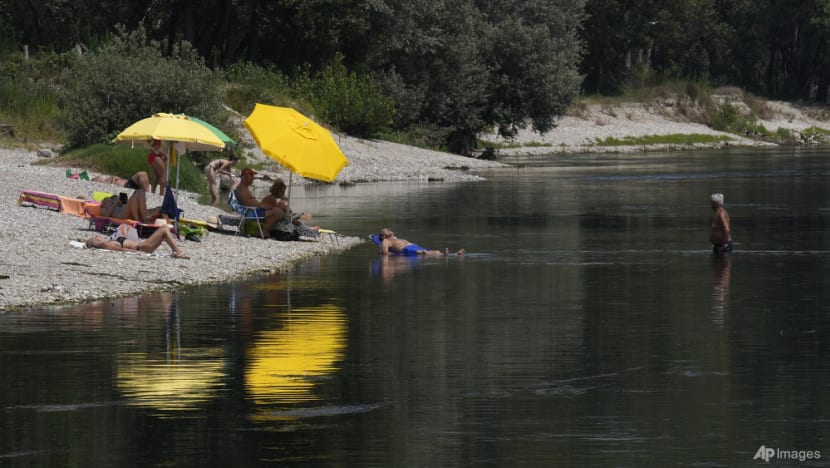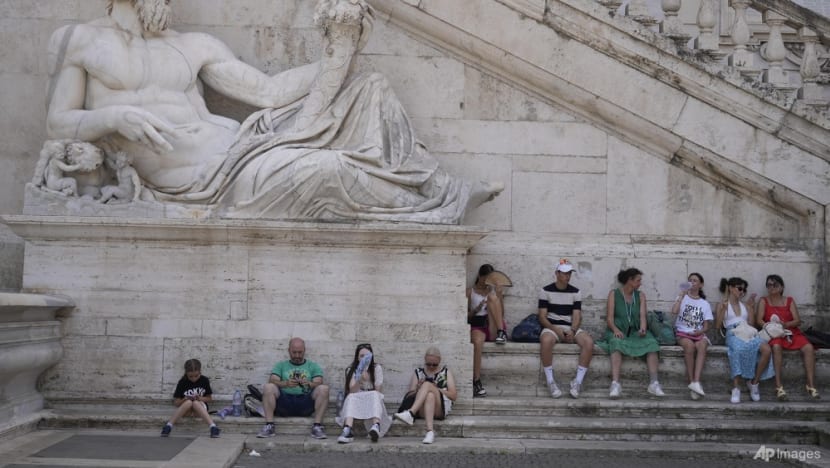Growing concern over low water levels, pollution in Italy’s lakes and rivers after extreme weather
Lower water levels mean pollutants cannot be washed away by the rivers, said observers.

People cool-off on the banks of the Ticino river in Bereguardo, near Milan, Italy, Tuesday, July 18, 2023. An intense heat wave has reached Italy, bringing temperatures close to 40 degrees Celsius in many cities across the country. (AP Photo/Antonio Calanni)
ROME: Environmental groups are increasingly concerned about the state of Italy’s lakes and rivers after months of prolonged hot spells and scorching temperatures.
The country has been at the forefront of extreme weather events. It is currently experiencing a significant drop in temperatures with strong winds and heavy rains, just days after a blistering heatwave.
Many of the nation's rivers and lakes are suffering from a severe lack of water due to the intense heatwaves and droughts, and environmental organisations are worried about the effects of climate change.
They are also sounding the alarm about increased pollution levels in the country’s waterways as a result of the extreme weather.
ENVIRONMENTAL GROUPS RAISE CONCERNS
In Rome, for instance, there are concerns over what lurks under the surface of its lakes, which are popular with tourists and locals alike. The Italian capital registered a record peak temperature of 41.8 degrees Celsius in July.
Environmental non-governmental organisation Legambiente recently found pollution beyond the legal limits at Lake Bolsena, about 1.5 hours’ drive north of Rome.
Mr Roberto Scacchi, president of Legambiente’s Lazio chapter, said there could be devastating consequences.
“The real problem is that alongside this type of microbiological pollution, there is devastating chemical pollution and the presence of nitrogen and phosphorus, which are specifically used in agriculture,” he added.
“It is incredible. It is very high, (and can) lead to the total eutrophication of the body of water. That means the collapse of the presence of oxygen, or the biological death of a lake, with practically nothing alive under two metres.”

However, not all of the region's lakes are in the same boat.
Legambiente said pollution levels at Lake Bracciano are steadily improving. This has a direct impact on people living in Rome, because the lake supplies the famous nasoni drinking fountains that can be found across the city.
MONITORING POLLUTION LEVELS
Environmental NGOs are also keeping a close eye on pollution levels in Rome’s two rivers, River Tiber, the third-longest river in Italy, and the Aniene, which feeds the Tiber.
Environmental justice organisation A Sud, for instance, has detected unsafe levels of E. coli and ammonium in both rivers.
A Sud activist Sara Vegni said last summer was a critical summer for the Tiber River.
“We look at rivers only to take advantage of them, that is, for humans. Instead, rivers themselves are very important ecological corridors and as such should be valued and also protected," she added.
When asked for their response to A Sud's findings, the local authorities in Rome did not provide a statement.
Meanwhile, with climate change leading to long periods of drought, a vicious cycle could be under way, observers pointed out.
They added that lower water levels mean harmful pollutants cannot be washed away by the river, which would leave the ancient Tiber unable to defend itself.
















